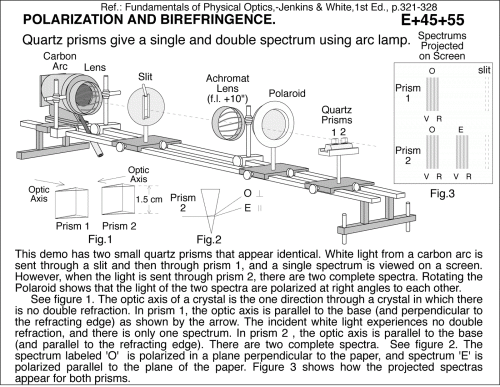Quartz prisms give a single and double spectrum, using arc lamp.
Primary tabs
This demo has two small quartz prisms that appear identical. White light from a carbon arc is sent through a slit and then through prism 1, and a single spectrum is viewed on a screen. However, when the light is sent through prism 2, there are two complete spectra. Rotating the Polaroid shows that the light of the two spectra are polarized at right angles to each other. See figure 1. The optic axis of a crystal is the one direction through a crystal in which there is no double refraction. In prism 1, the optic axis is parallel to the base (and perpendicular to the refracting edge) as shown by the arrow. The incident white light experiences no double refraction, and there is only one spectrum. In prism 2 , the optic axis is parallel to the base (and parallel to the refracting edge). There are two complete spectra. See figure 2. The spectrum labeled 'O' is polarized in a plane perpendicular to the paper, and spectrum 'E' is polarized parallel to the plane of the paper. Figure 3 shows how the projected spectras appear for both prisms. Quartz prisms give a single and double spectrum using arc lamp. Ref.: Fundamentals of Physical Optics,-Jenkins & White,1st Ed., p.321-328
UCB Index:
E+45+55
PIRA Index:
6H35.52
UCB Taxonomy:
PIRA Taxonomy:
Popularity:
- Log in to post comments

